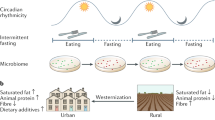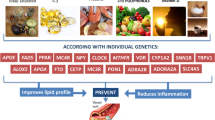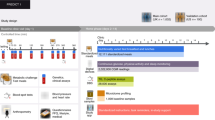Abstract
The explosion in genetic and biological information presents an opportunity to explore, and ultimately exploit for health benefits, the inter-individual differences in the body’s ability to metabolise, and respond to, nutrients. This has led to the concept of personalised nutrition as opposed to public health nutrition—the ‘holy grail’ of individualised dietary recommendations for optimal health. Using examples from micronutrient and lipid metabolism, this article assesses the scientific progress in our understanding of genetic influences on nutrition and its impact on risk of multifactorial diseases, and identifies the implications of research to date. Genetic variants that influence nutrient metabolism have been identified, but individual variants have not been conclusively linked to the risk of multifactorial diseases such as cancer and cardiovascular disease. Increasingly, it is realised that multiple variants influence nutrient metabolism and health outcomes. There is a need for quantitative assessment and mathematical modelling of multiple genetic effects. It is likely that personalised nutrition will not have the dramatic impact that was once expounded but will in the future, as we understand the complex influences of genetics, and impinge on the work of medical practitioners and dietitians by improving their ability to provide individual dietary advice and by contributing to the development of biomarkers.
This is a preview of subscription content, access via your institution
Access options
Subscribe to this journal
Receive 12 print issues and online access
$259.00 per year
only $21.58 per issue
Buy this article
- Purchase on Springer Link
- Instant access to full article PDF
Prices may be subject to local taxes which are calculated during checkout




Similar content being viewed by others
References
Debusk RM, Fogarty CP, Ordovas JM, Kornman KS . Nutritional genomics in practice: where do we begin? J Amer Diet Assn 2005; 105: 589–598.
Peters BA, Kermani BG, Sparks AB, Alferov O, Hong P, Alexeev A et al Nature 2012; 487: 190–195.
Jacobs B, De Angelis-Schierbaum G, Egert S, Assmann G, Kratz M . Individual serum triglyceride responses to high-fat and low-fat diets differ in men with modest and severe hypertriglyceridemia. J Nutr 2004; 134: 1400–1405.
Loktionov A . Common gene polymorphisms and nutrition: emerging links with pathogenesis of multifactorial chronic diseases. J Nutr Biochem 2003; 14: 426–451.
Corella D, Ordovas JM . Single nucleotide polymorphisms that influence lipid metabolism: interaction with dietary factors. Annu Rev Nutr 2005; 25: 341–390.
Genest JJ Jr, Martin-Munley SS, McNamara JR, Ordovas JM, Jenner J, Myers RH et al. Familial lipoprotein disorders in patients with premature coronary artery disease. Circulation 1992; 85: 2025–2033.
Joost HG, Gibney MJ, Cashman KD, Görman U, Hesketh JE, Mueller M et al. Personalised nutrition: status and perspectives. Br J Nutr 2007; 98: 26–31.
Haggarty P . B-vitamins, genotype and disease causality. Proc Nutr Soc 2007; 66: 539–47.
Ulrich CM, Potter JD . Folate supplementation: too much of a good thing? Cancer Epidemiol Biomarkers Prev 2006; 15: 189–193.
Fairweather-Tait SJ, Bao Y, Broadley MR, Collings R, Ford D, Hesketh JE et al. Selenium in human health and disease. Antiox Red Signal 2011; 14: 1337–1383.
Hesketh JE . Nutrigenomics and selenium: gene expression patterns, physiological targets, and genetics. Annu Rev Nutr 2008; 28: 157–177.
Hesketh J, Meplan C . Transcriptomics and functional genetic polymorphisms as biomarkers of micronutrient function: focus on selenium as an exemplar. Proc Nutr Soc 2011; 3: 1–9.
Forsberg L, de Faire U, Marklund SL, Andersson PM, Stegmayr B, Morgenstern R . Phenotype determination of a common Pro-Leu polymorphism in human glutathione peroxidase 1. Blood Cells Mol Dis 2000; 26: 423–426.
Jablonska E, Gromadzinska J, Reszka E, Wasowicz W, Sobala W, Szeszenia-Dabrowska N et al. Association between GPx1 Pro198Leu polymorphism, GPx1 activity and plasma selenium concentration in humans. Eur J Nutr 2009; 48: 383–386.
Villette S, Kyle JA, Brown KM, Pickard K, Milne JS, Nicol F et al. A novel single nucleotide polymorphism in the 3′ untranslated region of human glutathione peroxidase 4 influences lipoxygenase metabolism. Blood Cells Mol Dis 2002; 29: 174–178.
Meplan C, Crosley LK, Nicol F, Horgan GW, Mathers JC, Arthur JR et al. Functional effects of a common single-nucleotide polymorphism (GPX4c718t) in the glutathione peroxidase 4 gene: interaction with sex. Am J Clin Nutr 2008; 87: 1019–1027.
Gautrey H, Nicol F, Sneddon AA, Hall J, Hesketh J . A T/C polymorphism in the GPX4 3′UTR affects the selenoprotein expression pattern and cell viability in transfected Caco-2 cells. Biochim Biophys Acta 2011; 1810: 284–291.
Burk RF, Hill KE . Selenoprotein P—Expression, functions, and roles in mammals. Biochim Biophys Acta 2009; 1790: 1441–1447.
Al-Taie OH, Uceyler N, Eubner U, Jakob F, Mork H, Scheurlen M et al. Expression profiling and genetic alterations of the selenoproteins GI-GPx and SePP in colorectal carcinogenesis. Nutr Cancer 2004; 48: 6–14.
Meplan C, Crosley LK, Nicol F, Beckett GJ, Howie AF, Hill KE et al. Genetic polymorphisms in the human selenoprotein P gene determine the response of selenoprotein markers to selenium supplementation in a gender-specific manner (the SELGEN study). FASEB J 2007; 21: 3063–3074.
Meplan C, Nicol F, Burtle BT, Crosley LK, Arthur JR, Mathers JC et al. Relative abundance of selenoprotein P isoforms in human plasma depends on genotype, se intake, and cancer status. Antioxid Redox Signal 2009; 11: 2631–2640.
Curran JE, Jowett JB, Elliott KS, Gao Y, Gluschenko K, Wang J et al. Genetic variation in selenoprotein S influences inflammatory response. Nature Genet 2005; 37: 1234–1241.
Lietz G, Lange J, Rimbach G . Molecular and dietary regulation of beta,beta-carotene 15,15′-monooxygenase 1 (BCMO1). Arch Biochem Biophys 2010; 502: 8–16.
Borel P, Grolier P, Mekki N, Boirie Y, Rochette Y, LeRoy B et al. Low and high responders to pharmacological doses of beta-carotene: proportion in the population, mechanisms involved and consequences on beta-carotene metabolism. J Lipid Res 1998; 39: 2250–2260.
Hickenbottom SJ, Follett JR, Lin Y, Dueker SR, Burri BJ, Neidlinger TR et al. Variability in conversion of beta-carotene to vitamin A in men as measured by using a double-tracer study design. Am J Clin Nutr 2002; 75: 900–907.
Leung W, Hessel S, Méplan C, Flint J, Oberhauser V, Tourniaire F et al. Two common single nucleotide polymorphisms in the gene encoding β-carotene 15,15′-monoxygenase alter β-carotene metabolism in female volunteers. FASEB J 2009; 23: 1041–1053.
Ferrucci L, Perry JR, Matteini A, Perola M, Tanaka T, Silander K et al. Common variation in the beta-carotene 15,15′-monooxygenase 1 gene affects circulating levels of carotenoids: a genome-wide association study. Am J Hum Genet 2009; 84: 123–133.
Lietz G, Oxley A, Leung W, Hesketh J . Single nucleotide polymorphisms upstream from the β-carotene 15,15′-monoxygenase gene influence provitamin A conversion efficiency in female volunteers. J Nutr 2012; 142: 161S–165S.
Borel P, Moussa M, Reboul E, Lyan B, Defoort C, Vincent-Baudry S et al. Human plasma levels of vitamin E and carotenoids are associated with genetic polymorphisms in genes involved in lipid metabolism. J Nutr 2007; 137: 2653–2659.
Borel P, Moussa M, Reboul E, Lyan B, Defoort C, Vincent-Baudry S et al. Human fasting plasma concentrations of vitamin E and carotenoids, and their association with genetic variants in apo C-III, cholesteryl ester transfer protein, hepatic lipase, intestinal fatty acid binding protein and microsomal triacylglycerol transfer protein. Br J Nutr 2009; 101: 680–687.
Zhong H, Yang X, Kaplan LM, Molony C, Schadt EE . Integrating pathway analysis and genetics of gene expression for genome-wide association studies. Am J Hum Genet 2010; 86: 581–591.
McNulty H, Scott JM . Intake and status of folate and related B-vitamins: considerations and challenges in achieving optimal status. Br J Nutr 2008; 99: S48–S54.
Castillo-Lancellotti C, Tur JA, Uauy R . Impact of folic acid fortification of flour on neural tube defects: a systematic review. Public Health Nutr 2012; 31: 1–11.
Greene ND, Stanier P, Copp AJ. . Genetics of human neural tube defects. Hum Mol Genet 2009; 18: R113–R129.
Sutherland A, Kim DH, Relton C, Ahn YO, Hesketh J . Polymorphisms in the selenoprotein S and 15-kDa selenoprotein genes are associated with altered susceptibility to colorectal cancer. Genes Nutr 2010; 5: 215–223.
Meplan C, Hughes DJ, Pardini B, Naccarati A, Soucek P, Vodickova L et al. Genetic variants in selenoprotein genes increase risk of colorectal cancer. Carcinogenesis 2010; 31: 1074–1079.
Shibata T, Arisawa T, Tahara T, Ohkubo M, Yoshioka D, Maruyama N et al. Selenoprotein S (SEPS1) gene -105G>A promoter polymorphism influences the susceptibility to gastric cancer in the Japanese population. BMC Gastroenterol 2009; 9: 2.
Penney KL, Schumacher FR, Li H, Kraft P, Morris JS, Kurth T et al. A large prospective study of SEP15 genetic variation, interaction with plasma selenium levels, and prostate cancer risk and survival. Cancer Prev Res 2010; 3: 604–610.
Haug U, Poole EM, Xiao L, Curtin K, Duggan D, Hsu L et al. Glutathione peroxidase tagSNPs: associations with rectal cancer but not with colon cancer. Genes Chromosomes Cancer 2012; 51: 598–605.
Peters U, Chatterjee N, Hayes RB, Schoen RE, Wang Y, Chanock SJ et al. Variation in the selenoenzyme genes and risk of advanced distal colorectal adenoma. Cancer Epidemiol Biomarkers Prev 2008; 17: 1144–1154.
Jablonska E, Gromadzinska J, Sobala W, Reszka E, Wasowicz W . Lung cancer risk associated with selenium status is modified in smoking individuals by Sep15 polymorphism. Eur J Nutr 2008; 47: 47–54.
Steinbrecher A, Meplan C, Hesketh J, Schomburg L, Endermann T, Jansen E et al. Effects of selenium status and polymorphisms in selenoprotein genes on prostate cancer risk in a prospective study of European men. Cancer Epidemiol Biomarkers Prev 2010; 19: 2958–2968.
Da Costa LA, Badawi A, El-Sohemy A . Nutrigenetics and modulation of oxidative stress. Ann Nutr Metab 2012; 60: 27–36.
Timpson NJ, Forouhi NG, Brion MJ, Harbord RM, Cook DG, Johnson P et al. Genetic variation at the SLC23A1 locus is associated with circulating concentrations of L-ascorbic acid (vitamin C): evidence from 5 independent studies with >15 000 participants. Am J Clin Nutr 2010; 92: 375–382.
Cooper ML, Adami HO, Grönberg H, Wiklund F, Green FR, Rayman MP . Interaction between single nucleotide polymorphisms in selenoprotein P and mitochondrial superoxide dismutase determines prostate cancer risk. Cancer Res 2008; 68: 10171–10177.
Mao C, Qiu LX, Zhan P, Xue K, Ding H, Du FB et al. MnSOD Val16Ala polymorphism and prostate cancer susceptibility: a meta-analysis involving 8962 subjects. J Cancer Res Clin Oncol 2010; 136: 975–979.
Ambrosone CB, Freudenheim JL, Thompson PA, Bowman E, Vena JE, Marshall JR et al. Manganese superoxide dismutase (MnSOD) genetic polymorphisms, dietary antioxidants, and risk of breast cancer. Cancer Res 1999; 59: 602–606.
Knoblauch H, Bauerfeind A, Toliat MR, Becker C, Luganskaja T, Günther UP et al. Haplotypes and SNPs in 13 lipid-relevant genes explain most of the genetic variance in high-density lipoprotein and low-density lipoprotein cholesterol. Hum Mol Genet 2004; 13: 993–1004.
Imamura M, Maeda S . Genetics of type 2 diabetes: the GWAS era and future perspectives. Endocr J 2011; 58: 723–739.
Lees CW, Barrett JC, Parkes M, Satsangi J . New IBD genetics: common pathways with other diseases. Gut 2012; 60: 1739–1753.
Zeggini E, Scott LJ, Saxena R, Voight BF, Marchini JL, Hu T et al. Metaanalysis of genome-wide association data and largescale replication identifies additional susceptibility loci for type 2 diabetes. Nature Genet 2008; 40: 638–645.
Poulsen P, Kyvik KO, Vaag A, Beck-Nielsen H . Heritability of type II (non-insulin-dependent) diabetes mellitus and abnormal glucose tolerance--a population based twin study. Diabetologia 1999; 42: 139–145.
Aschard H, Lutz S, Maus B, Duell EJ, Fingerlin TE, Chatterjee N et al. Challenges and opportunities in genome-wide environmental interaction (GWEI) studies. Hum Genet 2012; 131: 1591–613.
Thomas D . Gene-environment-wide association studies: emerging approaches. Nature Rev Genet 2010; 11: 259–272.
Zhang Y . A novel bayesian graphical model for genome-wide multi-SNP association mapping. Genet Epidemiol 2012; 36: 36–47.
Lill CM, Bertram L . Developing the "next generation" of genetic association databases for complex diseases. Hum Mutat 2012; 33: 1366–1372.
Méplan C, Hesketh JE . Selenium and cancer: a story that should not be forgotten—insights from genomics. Cancer Treat Res 2012, (in press).
Ulrich CM, Neuhouser M, Liu AY, Boynton A, Gregory JF, Shane B et al. Mathematical modeling of folate metabolism: predicted effects of genetic polymorphisms on mechanisms and biomarkers relevant to carcinogenesis. Cancer Epidemiol Biomarkers Prev 2008; 17: 1822–1831.
Lluis-Ganella C, Subirana I, Lucas G, Tomás M, Muñoz D, Sentí M et al. Assessment of the value of a genetic risk score in improving the estimation of coronary risk. Atherosclerosis 2012; 222: 456–463.
Favé G, Beckmann M, Lloyd AJ, Zhou S, Harold G, Lin W et al. Development and validation of a standardized protocol to monitor human dietary exposure by metabolite fingerprinting of urine samples. Metabolomics 2011; 7: 469–484.
Scalbert A, Brennan L, Fiehn O, Hankemeier T, Kristal BS, van Ommen B et al. Mass-spectrometry-based metabolomics: limitations and recommendations for future progress with particular focus on nutrition research. Metabolomics 2009; 5: 435–458.
Author information
Authors and Affiliations
Corresponding author
Ethics declarations
Competing interests
The author declares no conflict of interest.
Rights and permissions
About this article
Cite this article
Hesketh, J. Personalised nutrition: how far has nutrigenomics progressed?. Eur J Clin Nutr 67, 430–435 (2013). https://doi.org/10.1038/ejcn.2012.145
Received:
Accepted:
Published:
Issue Date:
DOI: https://doi.org/10.1038/ejcn.2012.145
Keywords
This article is cited by
-
Personalized nutrition approach in pediatrics: a narrative review
Pediatric Research (2021)
-
Foodomics in bee product research: a systematic literature review
European Food Research and Technology (2021)
-
What Is the Optimal Dietary Composition for NAFLD?
Current Hepatology Reports (2017)
-
Personalized weight loss strategies—the role of macronutrient distribution
Nature Reviews Endocrinology (2014)
-
Risks of nutrigenomics and nutrigenetics? What the scientists say
Genes & Nutrition (2014)



